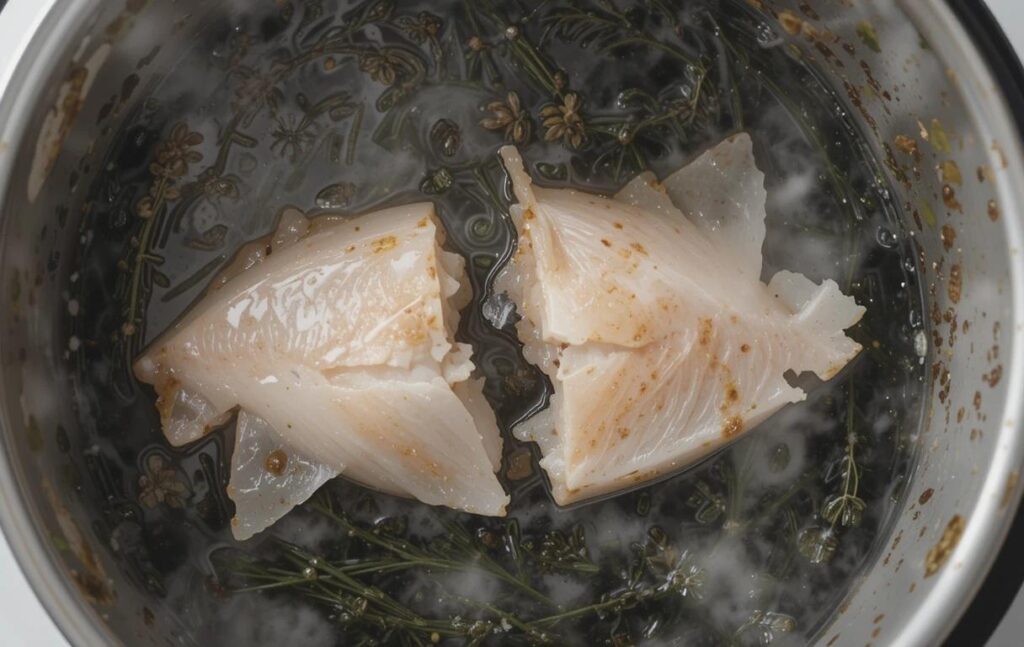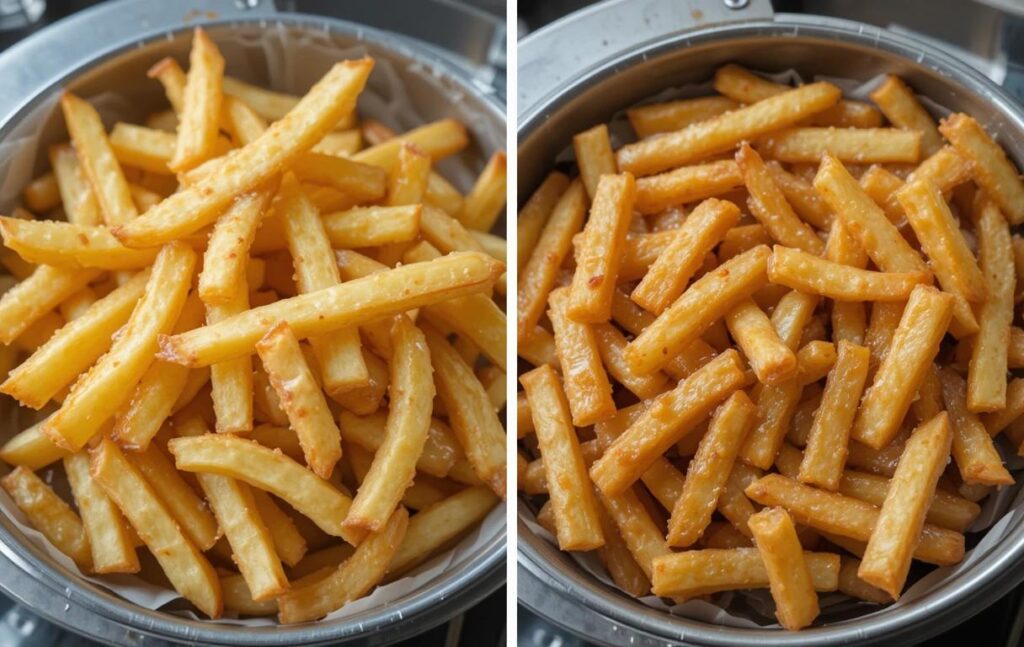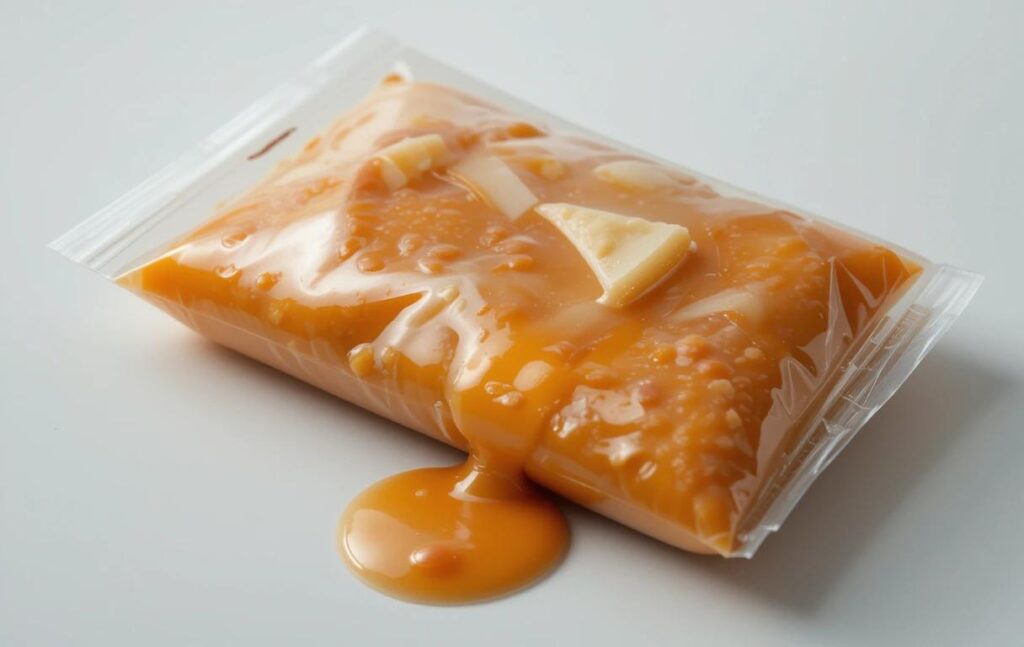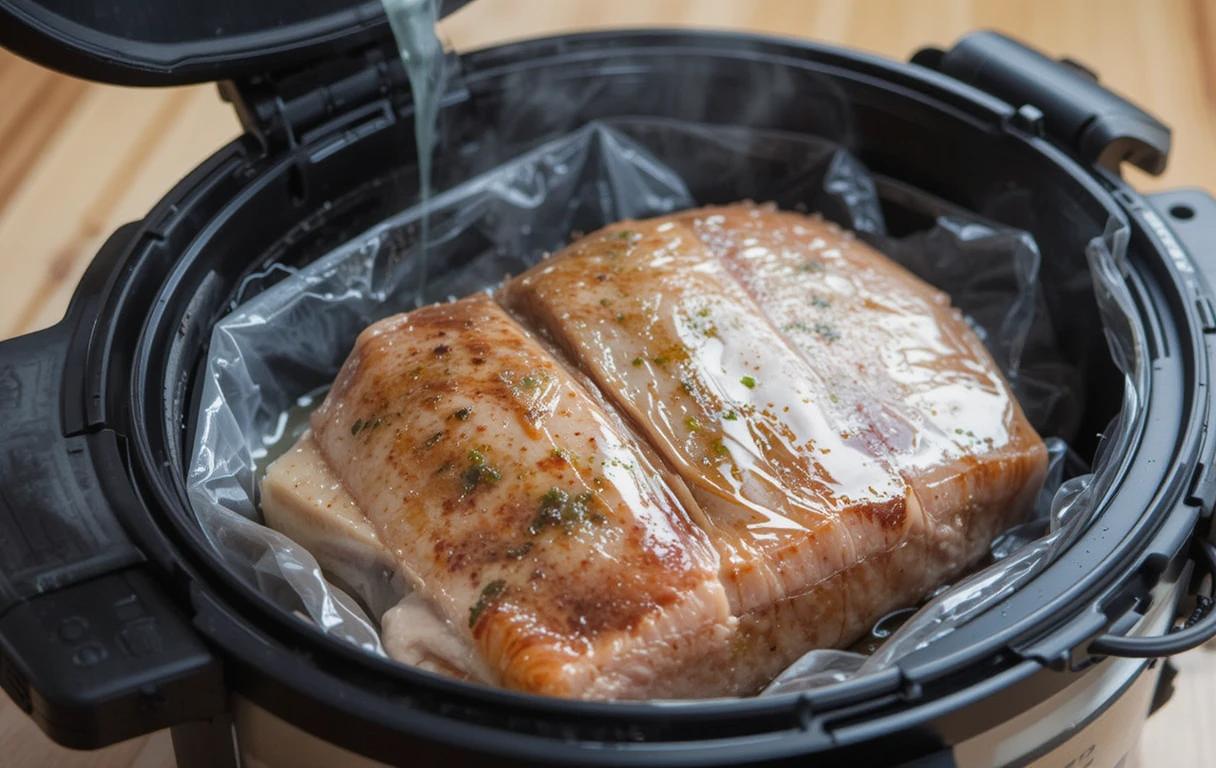Sous vide cooking has become a favorite technique for chefs and home cooks due to its precision and ability to retain moisture and flavor. However, not all foods benefit from this method. What cannot be cooked in sous vide? Foods requiring high heat, crispy textures, or instant results often fall short when prepared sous vide. Understanding these limitations will help you achieve better results in the kitchen.
When you explore the possibilities of sous vide, it’s equally important to recognize its constraints. From leafy greens to delicate dairy-based sauces, let’s delve into the foods you should avoid cooking sous vide and why.
Stay tuned for a detailed breakdown of the top 10 foods to avoid and actionable tips for smarter sous vide cooking.
1. Delicate Leafy Greens
Sous vide cooking relies on low and precise temperatures over extended periods, which is ideal for proteins and dense vegetables. However, delicate leafy greens like spinach, arugula, or lettuce are not well-suited for this technique.
Why Sous Vide Fails with Leafy Greens
Leafy greens cook quickly and require minimal heat to retain their structure and vibrant color. Sous vide tends to over-soften these greens, leaving them mushy and unappealing. The prolonged exposure to water bath temperatures often causes them to lose texture and become overly wilted.
For example, spinach, when cooked sous vide, can result in an unpleasant slimy texture, unlike the light sautéing or blanching methods that preserve its fresh qualities.
Best Alternatives
Instead of using sous vide, consider these methods for leafy greens:
- Steaming: Retains nutrients and a vibrant appearance.
- Sautéing: Adds a slightly crisp texture with minimal cooking time.
- Blanching: Ideal for leafy greens that require minimal softening, such as kale.
Pro Tip: If you want to incorporate leafy greens into a sous vide dish, cook the main components first and mix the greens in after cooking to maintain their fresh texture.
2. Crunchy Vegetables
Crunchy vegetables like carrots, celery, and radishes present another challenge for sous vide cooking. While sous vide excels at evenly cooking vegetables, achieving that desired “crunch” is often impossible.
The Problem with Crunchy Vegetables in Sous Vide
Sous vide cooks at lower temperatures, which soften vegetables instead of crisping them. For vegetables like carrots or celery, the crunchiness comes from their water content and cellular structure, which is not preserved during sous vide cooking. Instead, these veggies often become limp and lose their characteristic bite.
When It Works and When It Doesn’t
If your goal is tender, buttery carrots for a side dish, sous vide works wonders. However, if you need crisp carrots for a salad or crudités platter, stick to traditional cooking or raw preparations.
Better Cooking Techniques for Crunchy Vegetables
- Roasting: Locks in moisture while maintaining some crispness.
- Steaming: Cooks evenly without losing the crunch.
- Raw: When crunch is crucial, skip cooking altogether!
3. Certain Fish with Flaky Texture

Fish is one of the most popular ingredients for sous vide cooking, but not all types of fish are suitable. While dense and fatty fish like salmon or tuna work beautifully, delicate and flaky varieties such as cod, haddock, or sole can turn out less than ideal.
Why Flaky Fish Doesn’t Work Well
Sous vide’s long cooking times at precise, low temperatures can over-tenderize flaky fish, causing it to break apart easily. The delicate muscle fibers of these fish require minimal cooking time, and sous vide tends to exaggerate their fragility. Instead of a moist, tender fillet, you may end up with a disintegrated mess.
Additionally, these types of fish are prone to soaking up too much water during the sous vide process, leading to a soggy or overly watery texture.
Better Cooking Techniques for Flaky Fish
- Poaching: Gentle heat and a flavorful liquid make for moist, tender results.
- Steaming: Cooks fish quickly while preserving structure.
- Pan-Frying: A quick sear helps retain the fish’s flaky texture while adding a crispy exterior.
Pro Tip: If you insist on using sous vide for flaky fish, keep cooking times as short as possible and use vacuum-sealed bags to reduce water absorption.
4. Foods Needing High Heat for Maillard Reaction
One of the major limitations of sous vide is its inability to achieve the Maillard reaction—the browning and caramelization process that gives food a rich, complex flavor.
The Issue with High-Heat Cooking in Sous Vide
Sous vide cooking takes place in a water bath, which maxes out at the boiling point of water (100°C or 212°F). This temperature is insufficient to cause the Maillard reaction, which requires higher direct heat.
For dishes like steaks, burgers, or chicken wings, sous vide delivers perfectly cooked interiors but fails to provide that coveted crust or crispy exterior. Without additional cooking steps, these foods can come out looking pale and unappetizing.
Solution: Sear After Sous Vide
While sous vide alone cannot create a crust, finishing your dish with a sear on a hot skillet or grill solves the problem. This final step caramelizes the exterior and adds the desired flavor profile.
Foods That Need High Heat
- Steaks: Sous vide provides a perfect medium-rare interior, but a quick sear is essential for a flavorful crust.
- Chicken Wings: Crispy skin cannot be achieved in a water bath. Consider broiling or deep-frying after sous vide.
- Burgers: Use sous vide to cook evenly, then finish on the grill for that classic charred flavor.
5. Homemade Pasta or Bread Dough
Sous vide is an exceptional cooking method for many foods, but it’s ill-suited for dishes that rely on rising or developing a firm crust, such as pasta dough, bread dough, or pastries.
Why Sous Vide Doesn’t Work for Doughs
Bread and pasta dough require specific conditions for proper cooking or baking. Bread dough needs intense, dry heat to rise and form a golden, crispy crust. Sous vide’s low-temperature water bath cannot create the pressure or heat required for yeast to activate fully or for dough to set.
Similarly, pasta dough, which needs to be boiled in hot water for proper texture, becomes soggy and gummy if cooked sous vide. The controlled water bath does not reach the rolling boil necessary to cook pasta evenly.
Examples of Failed Dough-Based Foods
- Bread: Turns out dense and soggy due to the lack of dry heat for crust formation.
- Pizza Dough: Remains undercooked and floppy without the high heat needed to create a crisp base.
- Homemade Pasta: Becomes sticky and unevenly cooked in sous vide.
Better Alternatives
- For Bread: Bake in a conventional oven to achieve proper texture and crust.
- For Pasta: Boil in salted water for the classic al dente texture.
- For Pizza Dough: Use a pizza stone or grill for the high temperatures necessary for crisping.
Pro Tip: While sous vide cannot directly cook these items, you can use it to prepare toppings or fillings, such as a perfectly tender chicken breast or rich tomato sauce, for pairing with bread or pasta.
6. Foods Requiring Deep-Frying

Deep-frying is all about achieving that crunchy, golden-brown crust through immersion in hot oil. Sous vide, however, is a low-temperature cooking technique that lacks the ability to create this essential crispy texture.
Why Sous Vide Doesn’t Work for Fried Foods
The water bath used in sous vide cooking can only reach a maximum of 100°C (212°F). This is far below the temperatures needed for frying (typically 170°C to 190°C or 340°F to 375°F). Foods like French fries, fried chicken, or tempura need hot oil to create a crisp crust, which sous vide cannot replicate.
Additionally, attempting to fry foods after sous vide can sometimes lead to disappointing results. For example, French fries precooked sous vide may lack the starch or structure necessary to crisp up properly during frying.
Best Techniques for Deep-Fried Foods
- Frying in Oil: Stick to traditional deep-frying methods for consistent crunch.
- Double-Frying: For ultra-crispy results, par-fry foods at a lower temperature and finish with a higher-temperature fry.
- Air Fryers: If avoiding oil, air fryers can mimic the crispness of deep-frying without the mess.
When to Pair Sous Vide and Frying
While sous vide alone cannot achieve a crispy texture, it can be paired with frying to great effect. For example:
- Sous vide chicken wings can be finished in hot oil for extra-crispy skin.
- Sous vide pork belly can be fried for a crackling crust.
7. Dairy-Based Sauces
Cooking dairy-based sauces like Alfredo, béchamel, or cheese sauce in sous vide can be a recipe for disaster. The precise, slow heat of sous vide often causes dairy to curdle or separate, ruining the smooth and creamy consistency these sauces require.
Why Dairy Fails in Sous Vide
Milk, cream, and cheese are sensitive to temperature changes. Sous vide cooking can inadvertently overheat dairy products, causing the proteins to coagulate and form clumps. The result is a broken sauce with an unappealing, grainy texture.
Challenges with Dairy in Sous Vide
- Curdling: Prolonged exposure to low temperatures leads to protein separation.
- Oily Residue: Butter or cheese-based sauces may split, leaving a greasy layer.
- Lack of Emulsification: Sous vide cannot consistently whisk ingredients, which is critical for smooth sauces.
Better Alternatives for Dairy Sauces
- Stovetop Cooking: Allows for constant stirring and gradual temperature adjustments to maintain a smooth texture.
- Emulsion Blenders: Use an immersion blender to rescue partially broken sauces by re-emulsifying the ingredients.
- Controlled Heat: Use a double boiler for even heating when working with dairy-based sauces.
Pro Tip: While sous vide isn’t ideal for cooking dairy sauces, it can prepare the base ingredients. For example, sous vide garlic or vegetables can be blended into a stovetop béchamel for extra depth of flavor.
8. Thin Liquids Without Vacuum Bags

While sous vide excels at cooking foods in sealed environments, it struggles with thin liquids like broths, soups, or stocks unless carefully vacuum-sealed. The challenge lies in ensuring the liquid remains contained without leaking into the water bath.
The Problem with Sous Vide and Thin Liquids
Liquids like chicken stock or consommé can seep out of improperly sealed bags or jars during the sous vide process. This leakage compromises the integrity of the dish and can create a mess in the water bath. Even with vacuum sealing, liquids can make sealing difficult, as they tend to be drawn into the sealing area, preventing a tight closure.
Workarounds for Sous Vide and Liquids
- Vacuum Seal with Freezing: Freeze liquids into cubes before vacuum sealing to prevent spills during the sealing process.
- Use Mason Jars: Sous vide-safe jars are excellent for containing soups or sauces without the risk of leakage.
- Leave Headspace: If using jars, leave extra space to allow for liquid expansion during cooking.
Examples of Problematic Liquid Foods
- Clear Soups: Risk dilution or contamination from water bath.
- Marinades: Can mix with water if not properly sealed.
- Broths: Difficult to seal due to their thin consistency.
Pro Tip: Always double-check your sealing method when cooking with liquids. If a sous vide bag doesn’t feel secure, double-bag it for extra protection.
9. Overly Processed Meats
While sous vide is often lauded for its ability to cook proteins evenly, it is not ideal for overly processed meats such as hot dogs, deli meats, or pre-cooked sausages. These foods are already designed to be quick and easy to prepare, and sous vide often compromises their texture and flavor.
Why Processed Meats Don’t Work Well
Processed meats often contain additives, fillers, and preservatives that are already heat-treated during production. Subjecting these meats to sous vide cooking can result in:
- Texture Loss: Meats like hot dogs or bologna can become too soft or rubbery.
- Flavor Dilution: Prolonged sous vide can leach out the salt and spices, leaving a bland taste.
- Unnecessary Effort: Processed meats are already pre-cooked or prepared to be reheated quickly, making sous vide redundant.
Better Cooking Methods for Processed Meats
- Grilling or Pan-Frying: These methods add texture and flavor without compromising the integrity of the meat.
- Microwaving: For quick reheating, a microwave suffices and saves time.
- Steaming: Gently reheats deli meats or hot dogs without overcooking.
Pro Tip: If you’re experimenting with sous vide and processed meats, keep the cooking times very short and temperatures on the low end to avoid undesirable results.
10. Items Requiring Instant Cooking
Foods that rely on quick cooking techniques, such as scrambled eggs, stir-fries, or flash-seared proteins, are poor candidates for sous vide. These dishes depend on high heat and rapid preparation to retain their flavor, texture, and freshness.
Challenges with Instant-Cook Foods in Sous Vide
Sous vide is a time-intensive process, making it impractical for recipes designed for instant cooking. For example:
- Scrambled Eggs: Sous vide can create overly dense, rubbery eggs compared to the light, fluffy texture achieved on a stovetop.
- Stir-Fried Vegetables: Sous vide cannot replicate the high heat and quick cooking essential for maintaining the crispness and vibrant colors of stir-fried dishes.
- Thin Cuts of Meat: Thinly sliced proteins, such as flank steak for fajitas, cook faster on a grill or pan than in sous vide.
Better Alternatives
- Stir-Fry or Sautéing: Retains the fresh, crisp quality of vegetables and proteins.
- Direct Heat Cooking: Scrambled eggs or thin cuts benefit from fast stovetop preparation.
- Grilling: Ideal for quick sears and high-heat cooking.
Pro Tip: If you wish to combine sous vide with instant-cooking techniques, use sous vide for prep work, such as pre-cooking thicker cuts of meat, and finish with a high-heat method.
FAQs About What Cannot Be Cooked in Sous Vide
1. Can you cook all vegetables in sous vide?
No, certain vegetables, like celery or carrots, don’t retain their crunch when cooked sous vide. Steaming or roasting is better for these types of vegetables.
2. Why does sous vide fail with delicate fish?
Delicate fish like cod can fall apart because sous vide over-tenderizes their structure, making them too soft.
3. Can dairy-based sauces be cooked sous vide?
Not effectively. Dairy-based sauces tend to curdle or separate in sous vide due to prolonged exposure to heat.
4. Is sous vide suitable for processed meats?
Processed meats like hot dogs or pre-cooked sausages can lose their flavor and texture in sous vide. They’re better grilled or steamed.
5. What foods are time-inefficient in sous vide?
Foods that cook quickly, such as scrambled eggs or stir-fried vegetables, are impractical for sous vide due to the time investment.
6. Can liquids be cooked sous vide without a vacuum bag?
Thin liquids like soups or broths require careful sealing in jars or vacuum bags to prevent leakage.
Conclusion: Cooking Smart with Sous Vide
Sous vide is an extraordinary cooking method that provides precision, consistency, and unmatched flavor retention. However, it is not a one-size-fits-all solution. By understanding what cannot be cooked in sous vide—from delicate greens and flaky fish to instant-cook items and processed meats—you can avoid common pitfalls and use the technique where it truly shines.
Use sous vide strategically for proteins, dense vegetables, and complex recipes that benefit from slow, precise cooking, while reserving other methods for foods that require crisp textures, rapid heat, or unique preparation techniques. The more you understand sous vide’s strengths and limitations, the better your results will be in the kitchen!
Sous Vide Corned Beef
Related Recipes
- “Tuna Tomato Sauce Pasta Recipe“: A tomato-based recipe showcasing another way to use tomatoes.
- “Baked Chicken Fettuccine Alfredo with Broccoli“: Another comforting dish that can be complemented with tomato-based sauces.
Ingredient-Focused Content
- “Lions Mane Mushroom Recipe“: Suggest using a tomato gravy as a flavorful addition for plant-based dishes.
Cooking Techniques and Enhancements
- “Mango Habanero Salsa“: Explore complementary uses of sauces and gravies for flavor diversity.
Storage and Reuse Tips
- “Sous Vide Recipes“: Recommend tomato gravy as a sauce for sous vide-cooked meats or vegetables.
- “Ocean Spray Cranberry Sauce Recipe“: Guide readers on making and storing sauces, including tomato gravy.

